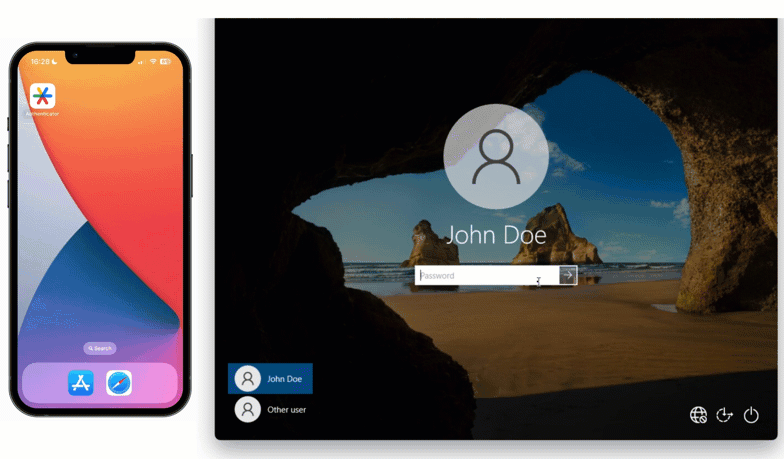Can I use an authenticator app with third-party MFA?
June 26, 2025 •
As more people rely on authenticator apps like Google Authenticator, Microsoft Authenticator, and others in their personal lives, organizations are looking for ways to integrate these familiar tools into their corporate multi-factor authentication (MFA) strategies.
Some third-party MFA solutions offer organizations the flexibility to enhance security while providing users with a seamless, straightforward login experience using the tools they already trust.
In this blog post, we’ll walk through why organizations might want to use authenticator apps, and a few common authentication scenarios where authenticator apps are paired with third-party MFA solutions.
Should I use a third-party authenticator app at my company?
There are many valid reasons why a company may want to use a common authenticator app to secure corporate logins and accounts. For example, some employees do not wish to download company-specific apps on personal devices.
Additionally, smartphone users are downloading fewer apps than ever. The average number of apps people download is expected to drop by 17% by 2027. Asking employees to download any corporate apps at all may be an impediment to getting MFA buy-in at your company.
Want to know more about authenticator apps? Check out our video: Authenticator App Authentication
Allowing employees to use common authenticator apps to load company tokens is an easy way to fight app-fatigue and make users feel more comfortable adopting company MFA.
Scenario One: Supporting Personal Authenticator Apps
Emma is a consultant for a marketing agency who often works remotely from client offices. Her company uses a third-party MFA provider to secure Windows Logon, VPN connections, and internal applications.
Since Emma already uses Google Authenticator to secure her personal accounts, she prefers not to install multiple authenticator apps on her phone.
Solution: Software OTP with Personal Authenticator Apps
Many third-party MFA solutions allow companies to issue time-based one-time passwords (TOTPs) compatible with popular authenticator apps.
When Emma logs into her company’s Citrix VPN, she enters her username and password, then selects “Authenticator App” as her second factor authentication method. She opens her personal authenticator app, locates the code associated with her corporate account, and enters the six-digit passcode when prompted.

This approach makes onboarding simple and removes friction for users already familiar with authenticator apps.
Scenario Two: On-Premises MFA with Authenticator App for Centralized Control
David is a systems administrator for a financial services firm that requires tighter security controls and centralized management of authentication tools. The company uses an on-premises third-party MFA platform to enforce MFA for all remote desktop connections and cloud applications.
David’s company enables Authenticator Apps as a method of logging in using their on-premises MFA solution.
Solution: On-Premises MFA with Authenticator App
Some third-party MFA solutions, including LoginTC Managed, offer the ability to use common authenticator apps with an on-premises MFA solution.
When logging in to his Windows device, David enters his username and password, selects “Authenticator App” from the MFA prompt, and opens the authenticator app to retrieve his one-time passcode.

This method gives IT teams better visibility and control over authentication devices and improves the overall security posture without sacrificing user convenience.
Solution: Offline on-premises authentication with Authenticator App
In the event that David’s computer is not connected to the internet, his IT department has also enabled offline authentication for his account. This requires no extra enrollment on David’s part.

When presented with the second factor authentication window, David inputs the one-time passcode into the space provided and successfully logins in.
This ensures seamless logins with no external dependencies whether online or offline.
Scenario Three: Transitioning from SMS Codes to Authenticator Apps
Lena works for a logistics company that historically relied on SMS-based MFA, owing to its ease of use and familiarity. However, recent security concerns about SIM swapping and phishing attacks prompted IT leadership to modernize their MFA approach.
Solution: Third-Party MFA with Software OTP Support
By deploying a third-party MFA solution compatible with software-based authenticator apps, Lena’s company gradually phases out SMS codes while offering an equally user-friendly authentication experience.
Now when logging into her Outlook Web App email, Lena can easily select “Authenticator App” and retrieve her code from the authenticator app linked to her account.

This method allows Lena’s company to tighten security while offering an equally simple and familiar alternative to SMS authentication.
Conclusion
As users become more comfortable using authenticator apps in their personal lives, integrating those tools into your organization’s MFA strategy can improve both security and user experience.
Third-party MFA solutions like LoginTC make it easy to support a range of authenticator apps, whether you want to allow personal apps, issue company-managed tokens, or replace other authentication methods.
By offering flexible authentication options, organizations can meet diverse user needs without compromising security.
Explore the full range of LoginTC authentication methods, and stay tuned for more use-case spotlights in our authentication solutions series.
Want to read this article as a PDF? Download Can I use an authenticator app with third-party MFA